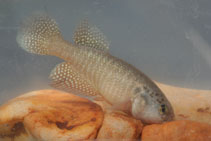| Family: |
Rivulidae (Rivulines), subfamily: Cynolebiinae |
| Max. size: |
5.45 cm SL (male/unsexed) |
| Environment: |
pelagic; freshwater; depth range 0 - 1 m |
| Distribution: |
South America: Brazil. |
| Diagnosis: |
Cynolebias parnaibensis is distinguished from all other species of the genus, except C. griseus and C. gilbertoi, by having 27-31 neuromasts around eye (vs. 33-46). The new species differs from C. griseus by having 29-33 supraorbital neuromasts (vs. 19-22), 16-18 dorsal-fin rays and 19 anal-fin rays in males (vs. 20-22 and 21-23, respectively), 28-31 caudalfin rays (vs. 33-34), 6 pelvic-fin rays (vs. 5), dorsal-fin origin at a vertical between the base of the 4th or 6th anal-fin ray (vs. base of 1st or 2nd ray), 33-36 scales in the longitudinal series (vs. 29-31), 3+10 gill-rakers in the first branchial arch (vs. 5+15), absence of second pharyngobranchial teeth (vs. presence), absence of the ventral uncinate process of the second epibranchial (vs. presence), absence of the ventral limb of the posttemporal (vs. presence), and absence of contact organs on the flank scales in both sexes (vs. presence in males). From C. gilbertoi it differs by having 34-35 vertebrae (vs. 32-33), and by the absence of teeth on vomer (vs. 13-15 vomerine teeth). Cynolebias parnaibensis is also distinguished from C. griseus, C. gilbertoi, C. microphthalmus sverse series of scales on the anal-fin base (vs. absence) (Ref. 84460). |
| Biology: |
The type locality of this species is inserted in the Caatinga domain, a semi-arid phytogeographic formation, typical of northeastern Brazil; the lagoon is within the Canindé River drainage, which is part of the Parnaíba River basin. It was about 60 m long, 15 m wide, maximum depth 1 m, average depth 50 cm; water is turbid, light brown, and the bottom was sandy-muddy; emerging aquatic vegetation in moderate amount, scattered over the lagoon surface, while large amount of submerged vegetation was found, the predominant species of the family Hydrocharitaceae. Margins of the pond were in part densely covered by bushes and low vegetation (Ref. 84460). |
| IUCN Red List Status: |
Data deficient (DD); Date assessed: 07 November 2018 Ref. (130435)
|
| Threat to humans: |
harmless |
Source and more info: www.fishbase.org. For personal, classroom, and other internal use only. Not for publication.

